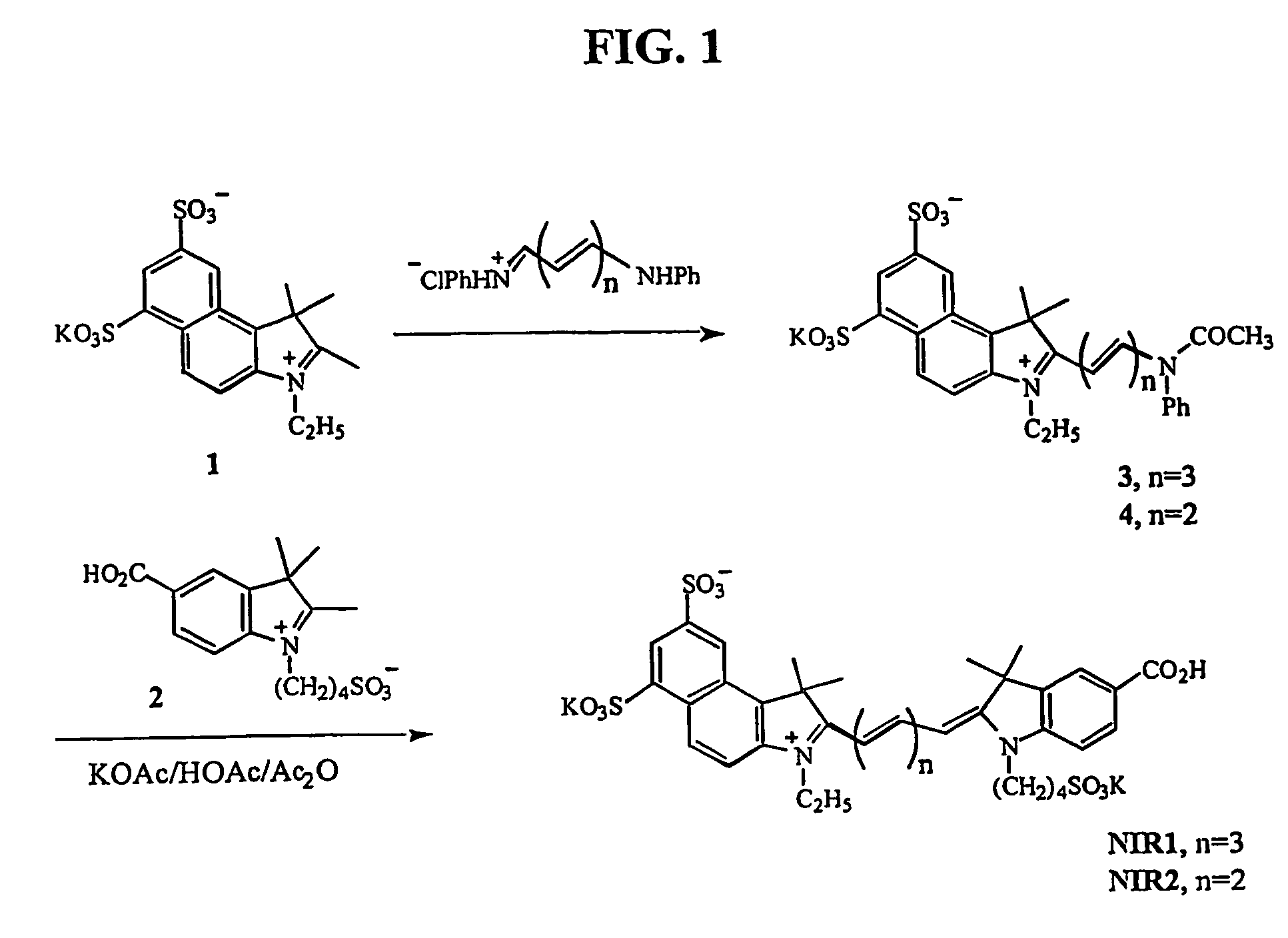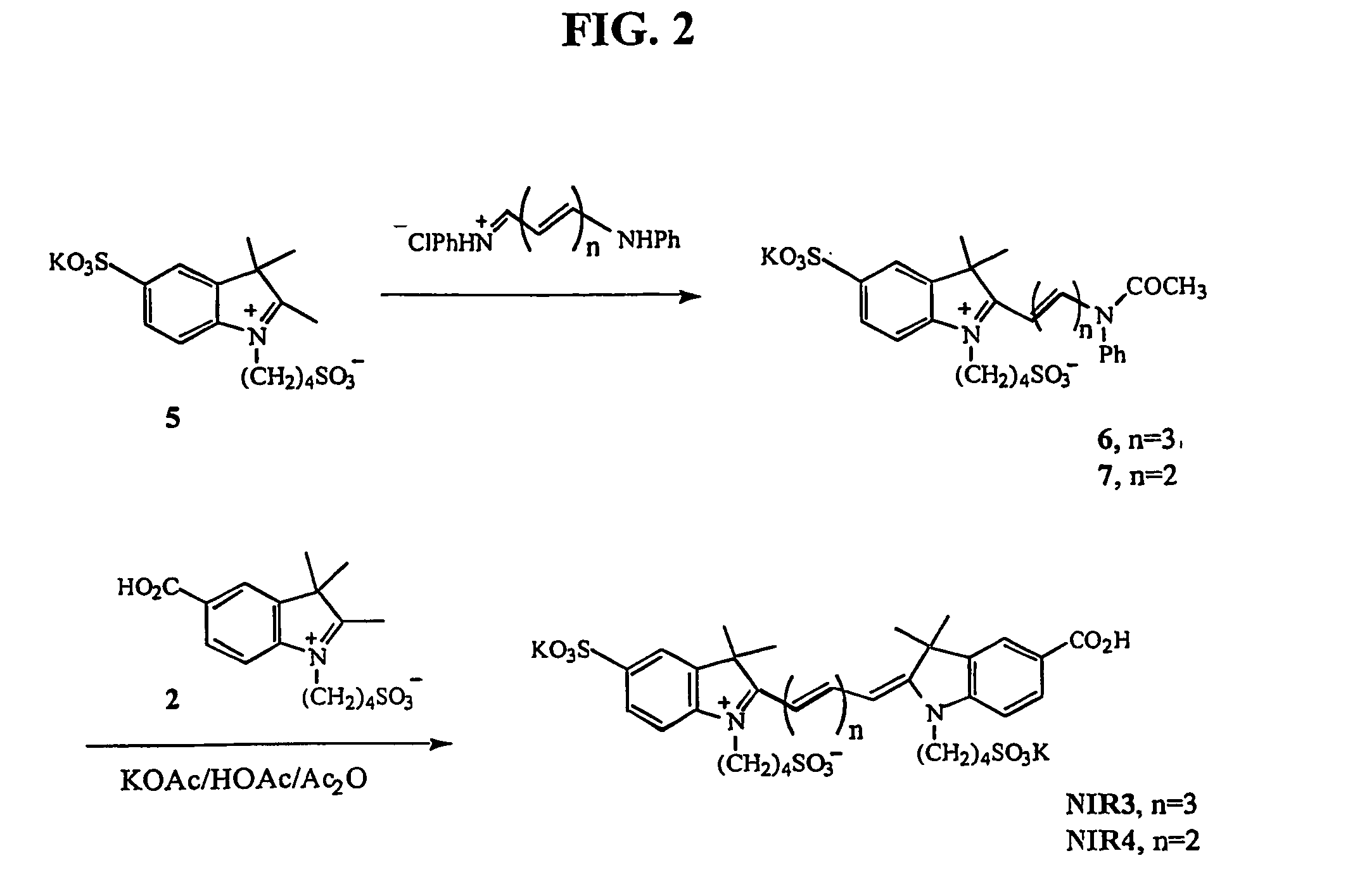Nir-fluorescent cyanine dyes, their synthesis and biological use
- Summary
- Abstract
- Description
- Claims
- Application Information
AI Technical Summary
Benefits of technology
Problems solved by technology
Method used
Image
Examples
example 1
Synthesis and Characterization of New Chromophores NIR1-4
[0159] Fluorochrome dyes NIR1, NIR2, NIR3, and NIR4 were synthesized according to the following procedure.
[0160] Starting Materials: 1,1,2-Trimethylbenzindoleninium 1 ,3-disulfonate dipotassium salt, 5-carboxy-1-(4-sulfobutyl)-2,3,3-trimethyl-3H-indolenin 2,1-(4-sulfonatobutyl)-2,3,3-trimethylindoleninium-5-sulfonate, and 5-chloroacetamido-1,3,3-trimethyl-2-methyleneindoli 10 were synthesized according to literature methods (Mujumdar et al., Bioconjug. Chem., 7:356-362, (1996); Terpetschnig et al., Anal. Biochem., 217:197-204 (1994); Mujemdar et al., Bioconug. Chem., 4:105-111 (1993), and Gale, D. J.; Wilshire, J. F. K. J. Soc. Dyers Colour. 1974, 90, 97-100, respectively). All compounds were used in crude form.
[0161] N-ethyl-2,3,3-trimethyl-benzindoleninium-5,7-disulfonate 1: 4.7 g of 1,1,2-trimethylbenzindoleninium 1,3-disulfonate dipotassium salt 8 ml of ethyl iodide (Aldrich Chemical Co., Milwaukee, Wis.), and 50 ml of ...
example 2
Determination of Extinction Coefficients of Fluorochrome Dyes
[0177] All of the new NIR fluorochrome dyes were purified twice by preparative HPLC, using a preparative HPLC instrument (Rainin, Woburn. Mass.) with a C18-RP preparative column (Vydec, Hesperia, Calif.) (flow rate=6 ml / min; eluant A, water with 0.1% TFA; eluant B, 90% of acetonitrile and 10% of eluant A; starting at 90% A for 5 min and then a linear gradient over 40 min to 50% A). The instrument's dual HPLC detector was set at 240 and 360 nm. The dyes were collected, and solvent was removed using a speed-vac concentrator (Savant, Holbrook, N.Y.).
[0178] The K+ions of the potassium salts were replaced with H+ to generate the corresponding free acids by ion-exchange chromatography (cation-resin, Dowex-50, 8% cross-link, 100-200 mesh).
[0179] About 20 mg of each fluorochrome dye was dissolved in 100 ml of deionized water. The absorbance was measured individually in three dilutions of the stock solution in deionized water or...
example 3
Activation of Fluorochrome Dyes
[0180] The cyanine dyes NIR1-NIR4 were converted to reactive N-succinyl esters using diisopropylcarbodiimide (DIPCDI) and N-hydroxysuccinimide in the presence of N-methylmorpholine in dimethylformamide (DMF) according to the reaction scheme shown in FIG. 5A. A nearly quantitative yield (typically >98%) was observed using reversed phase HPLC, as shown in FIG. 5B. The formation of active ester was not only confirmed by reverse phase HPLC, but also by reaction with benzylamine. FIG. 5B shows the HPLC of NIR2 (top chromatogram), as well as of its active ester (bottom chromatogram). Elution time for NIR2 and its active ester were 27.1 and 29.0 min, respectively. When the active ester reacted with benzylamine, the resultant NIR2-benzylamine conjugate showed an elution time of 32.1 min (HPLC profile not shown). The active ester was remarkably stable in water. According to PLC analysis, less than 10% of the active ester was hydrolyzed over a period of 20 days...
PUM
| Property | Measurement | Unit |
|---|---|---|
| Structure | aaaaa | aaaaa |
Abstract
Description
Claims
Application Information
 Login to View More
Login to View More - R&D
- Intellectual Property
- Life Sciences
- Materials
- Tech Scout
- Unparalleled Data Quality
- Higher Quality Content
- 60% Fewer Hallucinations
Browse by: Latest US Patents, China's latest patents, Technical Efficacy Thesaurus, Application Domain, Technology Topic, Popular Technical Reports.
© 2025 PatSnap. All rights reserved.Legal|Privacy policy|Modern Slavery Act Transparency Statement|Sitemap|About US| Contact US: help@patsnap.com



